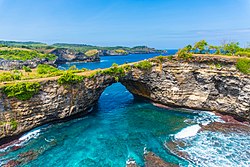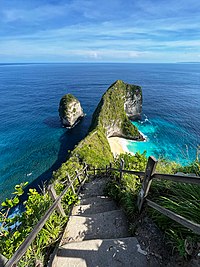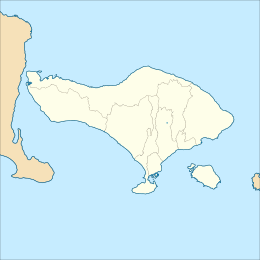Nusa Penida (Balinese: ᬦᬸᬲᬧᭂᬦᬶᬤ, romanized: nusa pĕnida) is an island located near the southeastern Indonesian island of Bali, which forms a district of the same name in Klungkung Regency. The Badung Strait separates the island and Bali. The interior of Nusa Penida is hilly with a maximum altitude of 524 metres, and the climate is drier than Bali. Like Bali, it is a major tourist destination.
Native name: ᬦᬸᬲᬧᭂᬦᬶᬤ (nusa pĕnida) | |
|---|---|
  Broken Beach (top) Kelingking Beach (bottom) | |
| Geography | |
| Location | South East Asia |
| Coordinates | 8°44′0″S 115°32′0″E / 8.73333°S 115.53333°E |
| Archipelago | Lesser Sunda Islands |
| Area | 202.84 km2 (78.32 sq mi) |
| Highest elevation | 524 m (1719 ft) |
| Administration | |
Indonesia | |
| Province | Bali |
| Regency | Klungkung |
| Nusa Penida | |
| Largest settlement | Batukandik (pop. 6,500) |
| Demographics | |
| Population | 63,900 (mid 2023[1]) |
| Pop. density | 315/km2 (816/sq mi) |
| Ethnic groups | Nusa Penidian and other minority ethnic group |
In addition to Nusa Penida, the administrative district of Nusa Penida includes the nearby islands of Nusa Lembongan and Nusa Ceningan, plus eleven even smaller islands. The district had a population of 45,110 at the 2010 census, covering 202.84 km2,[2] and the official estimate as of 2023 was 63,900.[1]
Language
editThe people of Nusa Penida speak a unique dialect of Balinese called Nusa Penida Balinese (basa Nosa), which cannot be understood by speakers from mainland Bali. It is reportedly close to the language of the Bali Aga, Bali's aboriginal population.[3]
Bali Bird Sanctuary
editNusa Penida, together with neighbouring Lembongan and Ceningan Islands, forms a bird sanctuary.[4] The island communities have used traditional Balinese village regulations to create the sanctuary. The idea of a sanctuary came from the Friends of the National Parks Foundation (FNPF).[5]
In 2006 all 35 villages (now 41 villages) agreed to make bird protection part of their traditional regulations (Balinese: ᬳᬯᬶᬕ᭄ᬳᬯᬶᬕ᭄, romanized: awig-awig). Since then, the FNPF has rehabilitated and released various Indonesian birds, most notably the critically endangered Bali starling which is endemic to Bali but whose numbers in the wild had declined to less than 10 in 2005. After a two-year program by FNPF in which 64 cage-bred birds were rehabilitated and released onto Nusa Penida, their number had increased to over 100 in 2009. Other released birds include the Java sparrow, Mitchell's lorikeet, and sulphur-crested cockatoo.[citation needed]
Destinations
editPoints of interest on Nusa Penida include:
Dive sites
editNusa Penida covers a wide area of diving locations, including Penida Bay, Batu Lumbung (Manta Point), Batu Meling, Batu Abah, Toya Pakeh, and Malibu Point.[6] The flow through the Lombok Strait is, overall, south-tending, although the strength and direction of the tidal streams are influenced by the monsoon seasons.
During the southeast monsoons, the tidal flow tends south; during the northeast monsoons, the tidal flow tends north. In the area of the strait north of Nusa Penida, the pattern is relatively simple, with a flow, at peak tide, of about three-and-one-half knots. Tidal streams in Badung Strait are semi-diurnal, but the character of the stream is very complicated because its direction runs obliquely to the general south-to-north direction of Lombok Strait, and the channel has a curved shape.
Based on a survey in 2009, there were about 1,419 hectares of coral sites with 66 percent covering the sites in 3 metres depth and 74 percent covered the sites in 10 metres depth.[7]
In December 2024, a colony of Galaxea astreata, one of the largest coral colonies in the world, was discovered, covering an area of approximately 4000 m² with dimensions 34 m (width), 32 m (length) and 5.5 m (height).[8]
See also
editReferences
edit- ^ a b Badan Pusat Statistik, Jakarta, 28 February 2024, Kabupaten Klungkung Dalam Angka 2024 (Katalog-BPS 1102001.5105)
- ^ "Nusa Penida (Eiseman, 1986)".
- ^ .co/2020/05/17/basa-nosa-language-bali-dialek-nusa-penida-yang-similar-dialek-bali-aga/ ""Basa Nosa", the Balinese dialect of Nusa Penida which is similar to the Bali Aga dialect?" (in Indonesian). I Ketut Serawan. 17 May 2020. Retrieved 4 July 2022.
{{cite web}}: Check|url=value (help) - ^ fnpf.org
- ^ Friends of the National Parks Foundation (FNPF).
- ^ Erviani, Ni Komang (30 May 2011). "Administration to improve access to Nusa Penida". The Jakarta Post. Klungkung, Bali.
- ^ "Nusa Penida Kaya Potensi namun Belum Menyejahterakan". March 10, 2013.
- ^ Vincent Chalias (2024-12-07). "Could This Be the World's Largest Coral Colony? Nusa Penida's Galaxea astreata Stuns Scientists". Ocean Gardener. Retrieved 2025-01-01.
External links
edit- Nusa Penida travel guide from Wikivoyage
- Southeastern Islands travel guide from Wikivoyage
